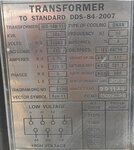tipu_sultan
Member level 1
Suppose there is a power step-down transformer of ratings. [Name-Plate Attached].

100KVA
HV Side specifications:-
volts-> 11KV
current-> 5.25
LV Side specifications:-
volts-> 0.415KV
current-> 139.1
P=VI
p=11x10^3 * 5.25 = 57750
P=0.415x10^3 * 139.1 = 57726
Can any one help me about calculation? I believes that power should be 100KVA as mentioned in the transformer's nameplate?
Another Question (Power is same):-
If a man accidentally contacts with the transformer either LV side or HV side which one is dangerous?
I want to say that high current is harmful or high voltage is harmful?
From which side man get more shock (LV or HV) as power is same on both sides?
Consider another case (My Confusion):-
The overhead cables have the high voltage but little current it is dangerous and may cause Arc Flash. I believe that if a man contact with them (if path completes) he dies due to high voltage.
We can limit the current by using RCD, MCB etc
If we limit the current of very high voltage say 33KV to 3A then my question is that if someone contact with them he gets shock or not?
How to justify the LV and HV side of transformer by ANALOGY OF ELECTRICITY (Flow of Water in Garden Hose) figure attached?

Say from HV Side
cable used is -> 3Cx300mm2
From LV Side
cable use is -> 3Cx300mm2
Both LV and HV have the same cable used so that means have the same resistance but the voltage & current of either side of Voltages is different.
How to justify it.
Same pipe area water pressure is high and water flow is slow etc.....

100KVA
HV Side specifications:-
volts-> 11KV
current-> 5.25
LV Side specifications:-
volts-> 0.415KV
current-> 139.1
P=VI
p=11x10^3 * 5.25 = 57750
P=0.415x10^3 * 139.1 = 57726
Can any one help me about calculation? I believes that power should be 100KVA as mentioned in the transformer's nameplate?
Another Question (Power is same):-
If a man accidentally contacts with the transformer either LV side or HV side which one is dangerous?
I want to say that high current is harmful or high voltage is harmful?
From which side man get more shock (LV or HV) as power is same on both sides?
Consider another case (My Confusion):-
The overhead cables have the high voltage but little current it is dangerous and may cause Arc Flash. I believe that if a man contact with them (if path completes) he dies due to high voltage.
We can limit the current by using RCD, MCB etc
If we limit the current of very high voltage say 33KV to 3A then my question is that if someone contact with them he gets shock or not?
How to justify the LV and HV side of transformer by ANALOGY OF ELECTRICITY (Flow of Water in Garden Hose) figure attached?

Say from HV Side
cable used is -> 3Cx300mm2
From LV Side
cable use is -> 3Cx300mm2
Both LV and HV have the same cable used so that means have the same resistance but the voltage & current of either side of Voltages is different.
How to justify it.
Same pipe area water pressure is high and water flow is slow etc.....
Last edited: